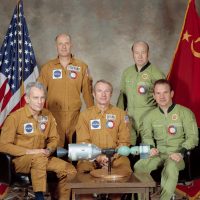The first episode of From the Earth to the Moon, “Can We Do This?”, narrates the beginning of the race to the moon. The episode opens with Yuri Gagarin’s flight into space (sixty years ago next month) and the Americans’ reaction to it. The episode goes on to portray the first flight of the Mercury program and a couple of selected missions from Project Gemini: Gemini 4 (the first spacewalk), Gemini 8 (the first docking, followed immediately by a malfunction that caused the spacecraft to spin out of control), and Gemini 12 (the last mission of the program). When the episode ends, astronaut chief Deke Slayton calls the astronauts together to brief them on plans for a manned landing on the moon.
Narratively, the episode is a bit of a hodgepodge, but its main purpose is to set the stage for the stories to come in subsequent episodes. The four space missions featured in this episode all introduce a character who will play an important role in one or more of the later episodes. The first Mercury flight is piloted by Alan Shepard, who flies to the moon in the ninth episode. The spacewalker on Gemini 4 is Ed White, who dies in the Apollo 1 fire in the next episode. Neil Armstrong is on Gemini 8 and Buzz Aldrin on Gemini 12; they will be the first men to land on the moon in the sixth episode.
A much stronger episode – one of the best of the show – is Part 2, “Apollo One.” This episode tells the tragic story of the Apollo 1 fire that killed three astronauts during a ground test of the space capsule on January 27, 1967. The episode opens with a well-staged reenactment of the fire itself. The main plotline of the episode revolves around the investigation into the disaster and its repercussions within NASA and North American Aviation, the contractor that built the spacecraft.
The first thing that I noticed when watching these episodes for the first time in more than a decade was the production values. The show was produced for television in the late-nineties, and it looks dated now. Although the production values were higher than for full-season episodic television at the time, they are lower than for TV now. (Within the past ten years or so, TV shows have gotten into a production values arms race. The results are impressive but may not be sustainable.) The episodes are shot in the aspect ration 4:3, to fit on pre-HDTVs. Characters talk about things, or hear them on the radio, rather than seeing the events themselves. Events are also portrayed by stock footage or period photographs, with the show’s actors photoshopped in over the real people where necessary. The production clearly had limited resources, and sometimes it shows.
Two aspects of the episodes compare favorably to TV shows now: the music and some of the effects. The Mercury and Gemini spacecraft in the first episode are portrayed by physical models rather than CGI. Although the compositing isn’t always as good as it could be, the models look great. They have a physicality and even warmth that CGI models never seem to be able to match. As for the show’s music, it is beautiful and stirring and, what’s more, made with real instruments, not computers.
When watching the first two episodes, I noticed some errors that I had never seen before. They are nothing major, but they served as a reminder that I was, after all, watching a TV show made in the late nineties, not real space missions from the sixties. Here are two errors that I noticed:
- In Part 1, Gemini 8 is over the Indian Ocean and heading east when it spins out of control. This is mentioned in a line of dialogue, and it is also shown on the map in Mission Control. And yet the effects shots show the spacecraft flying over the eastern Mediterranean, with the unmistakable island of Cyprus clearly visible!
- Part 2 has some nice location shots from the Mall in Washington, DC. One is shot at the Ulysses S. Grant Memorial near the Capitol and the other is shot at the other end of the Mall near the Lincoln Memorial and the reflecting pool. There are a couple of nineties-era cars visible in the background in these scenes.




Leave a Reply